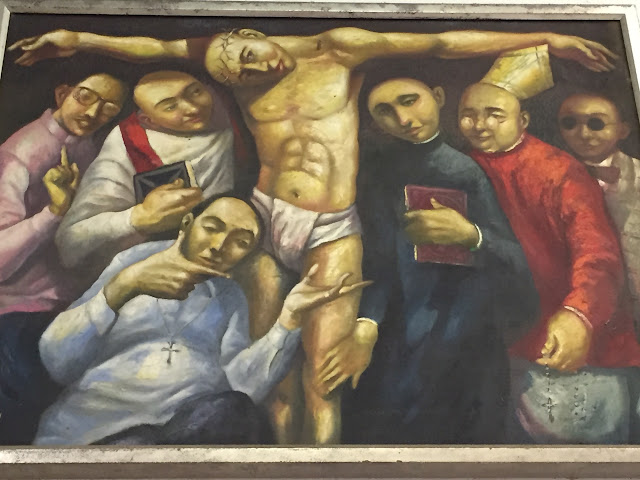That's called art?!?
Pintô Art Museum, Antipolo, Rizal—The province of Rizal has always been known as a hub of visual arts. For some strange reason, many painters and sculptors hail from this province. Angono is a town known for its artworks. It's literally an outdoor art gallery, the last time I was there! Anyway, my annual art/culture field trip to celebrate Jose Rizal's birthday led me (with my friends) to Silangan Gardens in Rizal, to visit Pintô Art Museum.
Pintô Art Museum opens its door (get it?) to people who want to see contemporary art and to learn how to decipher and appreciate the artists' messages. Of course, everything in the museum is subject to the viewers' interpretation but it's also healthy to listen in on what the artist wanted to say through the piece. I am not a fan of contemporary art—I've seen quite a few modern art museums and I'd always left scratching my head in puzzlement—so this, to me, was a welcome arts appreciation lesson.
Let's go down, willingly, the garden path, shall we? All interpretations are mine... and they're not necessarily correct.
The galleries started off with pieces that were easy on the eyes... probably easing us into going beyond looking and finally start seeing meaning out of abstraction. We begin the journey with this piece. It reminds me of an artwork in the Burning Man. I liked this piece because it shows caring and empathy between two people. It's almost as if they did not need to talk because they could read each other already.
This next piece is, I think, about one disappearing slowly. Here is a shy person who's slowly blending into the background. The sadder thing about this is that nobody will actually notice that he's no longer there. For me, it's a symbol of people who are always taken for granted, who are not appreciated, who work behind the scenes... this is a tribute to the wind beneath everyone's wings; a reminder, perhaps, to be thankful for every act of kindness.
The artistic style in the painting reminds me of van Gogh. There's an ethereal, out-of-this-world feel to this representation of Silangan Gardens. It is one of my favourite pieces in the museum.
This piece is entitled Maria Makiling, I think. I've seen many statues about the guardian of the mountain. However, this is the first time I've seen her represented in such a dire state. The woman is definitely not happy. Perhaps, this piece is all about deforestation, the destruction of natural resources, the endangerment of wildlife, and human encroachment.
I was most fascinated by classic paintings recreated to look like they're still covered in bubble wrap. The scene in the painting is of Jesus calming the storm, a classic theme in paintings. It resembles the Rembrandt original... with the one major revision: the addition of bubbles all over. It, therefore, now looks like a newly commissioned piece about to go up in an art museum. It speaks of new ownership, of new appreciation, perhaps. It also seems to convey the message of art being inaccessible to ordinary people. We see it only through bubble wrap.
The invisible man was already in such a sad fading state... then it became worse because he got into an motorcycle accident.
This guy didn't value his safety. He wanted to be famous and so he got himself a Ducati. The thing is, he's had enough to buy the bike but not the helmet or the safety gear. Not the most intelligent of decisions, right?
Religion has been portrayed here as something that can only be lived fully by people from higher social classes (i.e., the church leaders). The crucified man is surrounded by religious leaders who are supposedly our direct link and guide towards eternal life. That kind of religious exclusivity was a pet peeve of religious secessionists back during the Spanish era.
I felt quite bad when I totally forgot to bring my SLR with me on this trip... the sky was overcast, perfect for a photo shoot! As I checked out the sky, I noticed this piece about a gymnast. I liked the fluid motion from one stage to the next.
With all the chaos happening globally, I was affected by this sketch. It's a reminder that we're a team; we are one boat; we need each other's support.
And then there were the pieces that made me go: "that's art?!"
So sorry to the artist but I don't get this one. Ate Mary said it might really be about the three ducks. But I was not convinced. It was difficult for me finding a story in it.












Comments
Post a Comment
Thank you for dropping by!
Before moving on, please share your thoughts or comments about the post. :)
Thanks again!